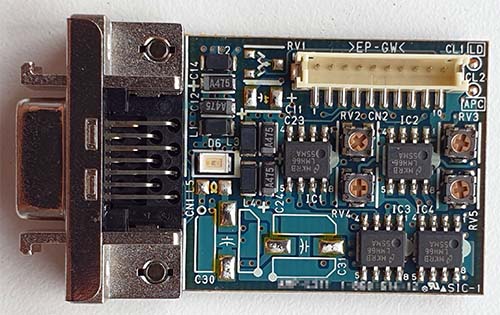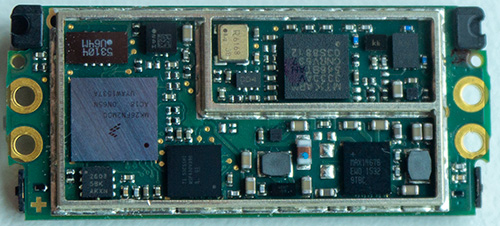The Ware for April 2022 is shown below.
This is once again another fine Don Straney ware; thank you for the contribution!
The Ware for March 2022 is the front-end electronics module for a Sony (now Magnescale) BL55 laser scale. The winner is Eben Olson (congrats, email me for your prize!), but Willmore guessed the full model number after the “interesting half” was also posted (I’m impressed!). It’s pretty amazing how a full laser interferometer is packed into such a tiny package; it’s the sort of thing that I wouldn’t believe was possible until I saw it with my own eyes.
The Ware for March 2022 is shown below.

This is arguably only “half” of the ware, and the much less interesting half at that. If folks struggle to guess the entire function, I’ll edit this post to include an image of the other half of the ware, which will probably end up being a dead give-away.
Either way, I’ll eventually update this post to show the whole ware, because it’s a pretty interesting little device.
Edit— Eben Olson got about as close as anyone can get on the ware without showing the other half! So, I’ll reveal it now. I think in practice nobody could guess the exact model number since this this specific unit has been EOL for a while. Pretty fascinating bit of optics, I’ll have to say; there’s a lot of art in this device.
I’m guessing this is the sort of thing I couldn’t buy new in Asia right now without filling out a bunch of export control forms, given the harassment I’ve experienced trying to acquire other advanced test and measurement equipment lately. It’s exactly the type of technology that would be strategic to control in a trade war: it’s essential in the construction of semiconductor fab equipment, plus I wouldn’t be surprised if there was only one or two sources capable of producing a laser scale of this quality, compactness, and clean room-readiness.
The Ware for February 2022 was a Garmin Vivoactive smartwatch. SAM correctly guessed it, down to the model number and FCC ID. Great work! Congrats, and email me for your prize!
The Ware for February 2022 is shown below.

I was cleaning out my desk and decided to give this a crack and see what was inside. There’s a couple things I found notable about the design. First, basically every part on the inside is a catalog part or an OEM variant of one — I’m used to opening up these types of devices and seeing more full custom ASICs, weirdo unsearchable Japanese or Chinese part numbers, or anonymous black globs of glue. It’s kind of neat that catalog parts have caught up to the point where you could build one of these essentially just ordering stuff off of Digi-Key (alternatively, one could lament that it’s sad that “Moore’s Law” (in the broader sense) has slowed to the point where it’s no longer economically viable to spin custom ASICs even for products like this). Second, I really liked the antenna. It’s making good use of all three spatial dimensions, yet the design is clean and simple. It is a little bit odd, though, that no underfill was used to secure any of the chips, but maybe that’s part of the reason why it’s in my scrap pile.